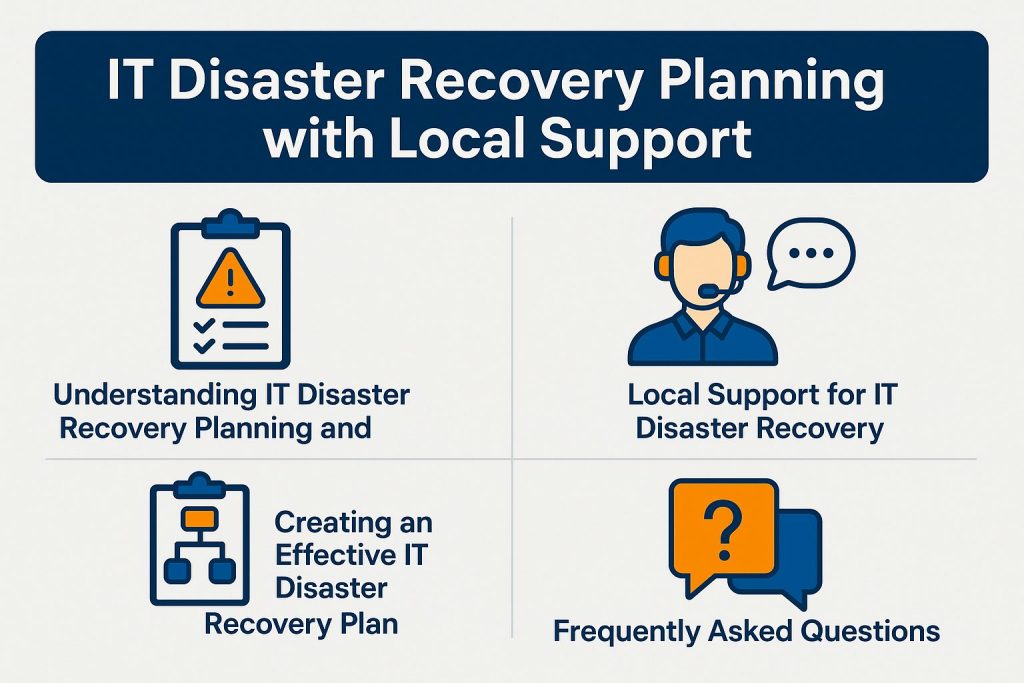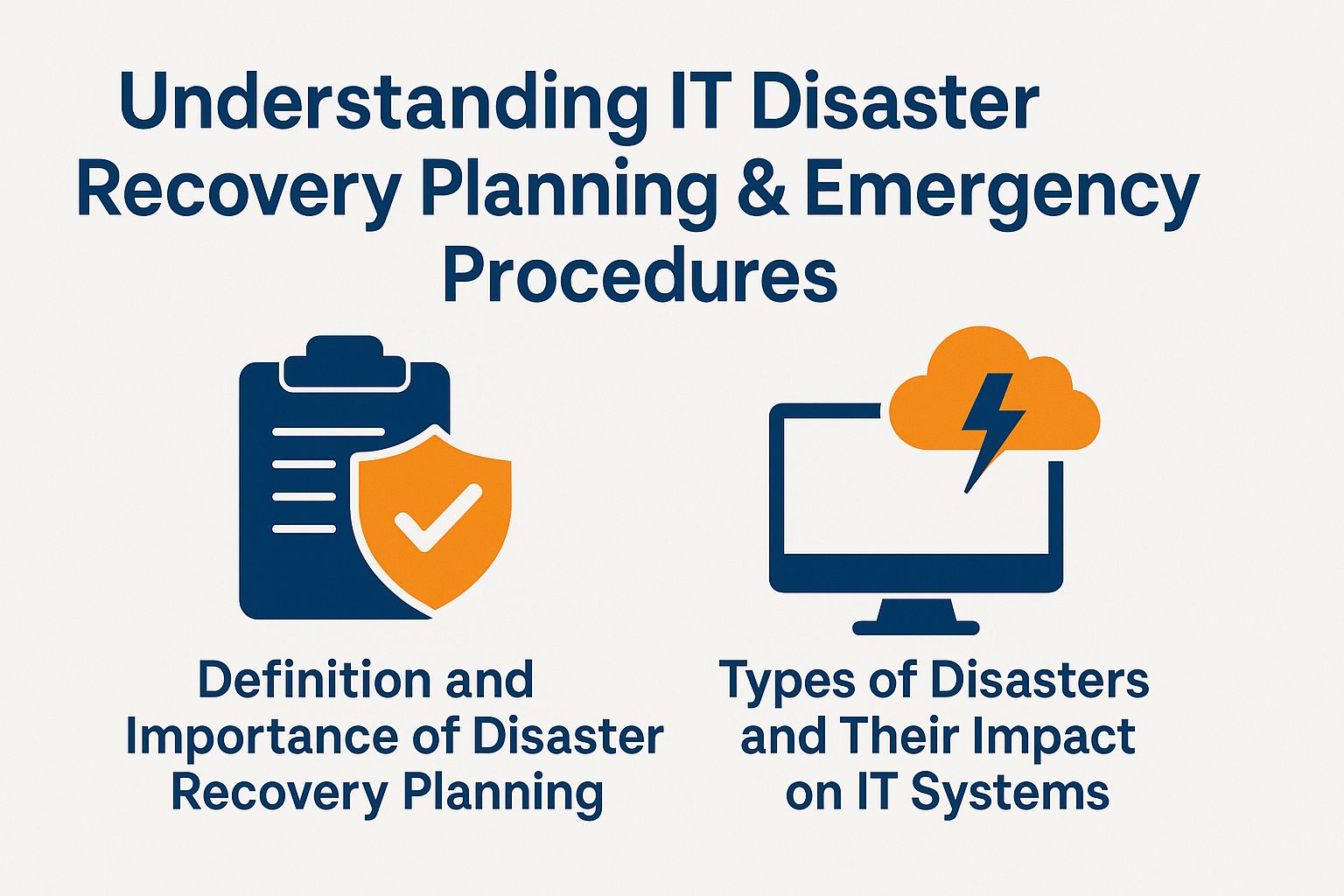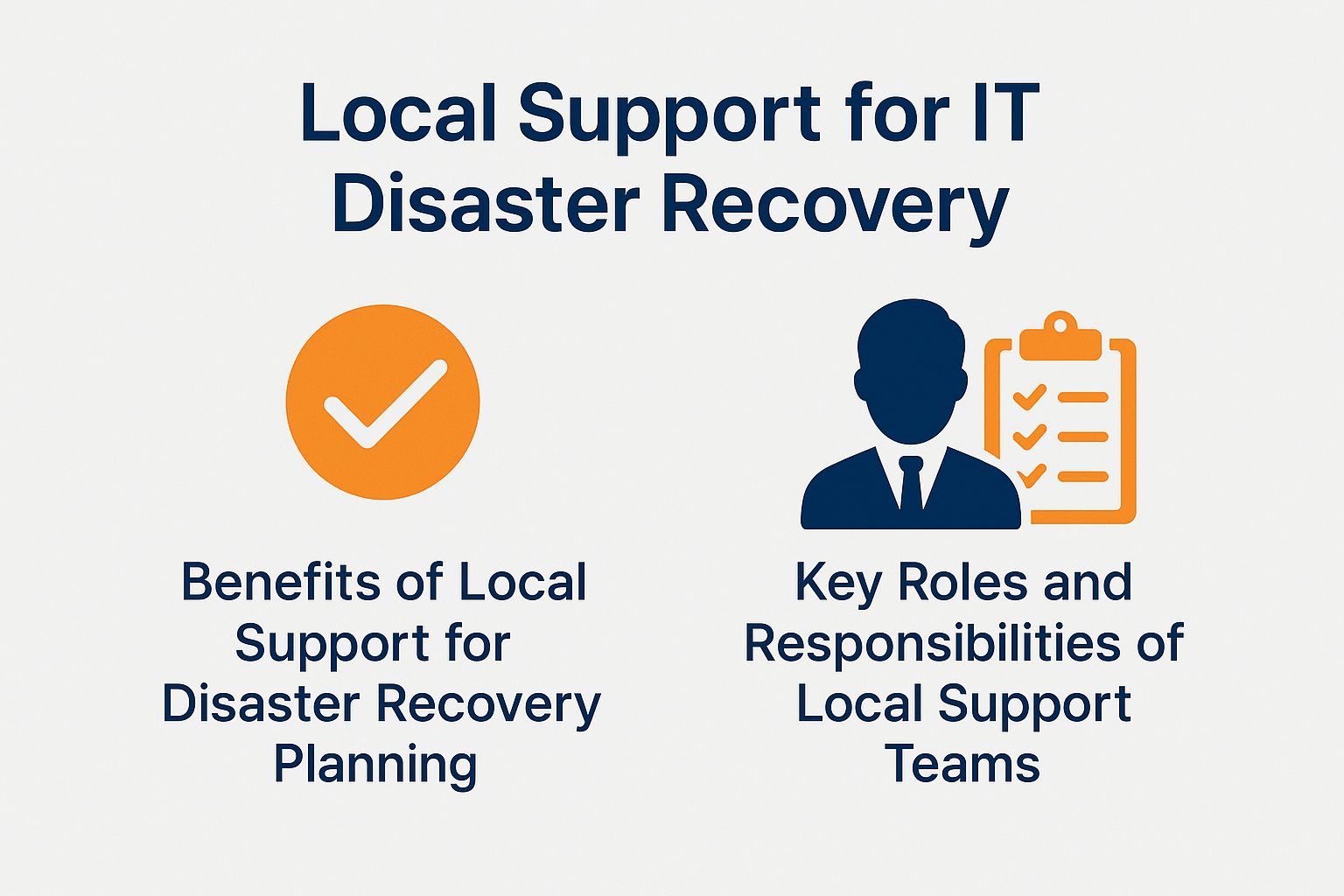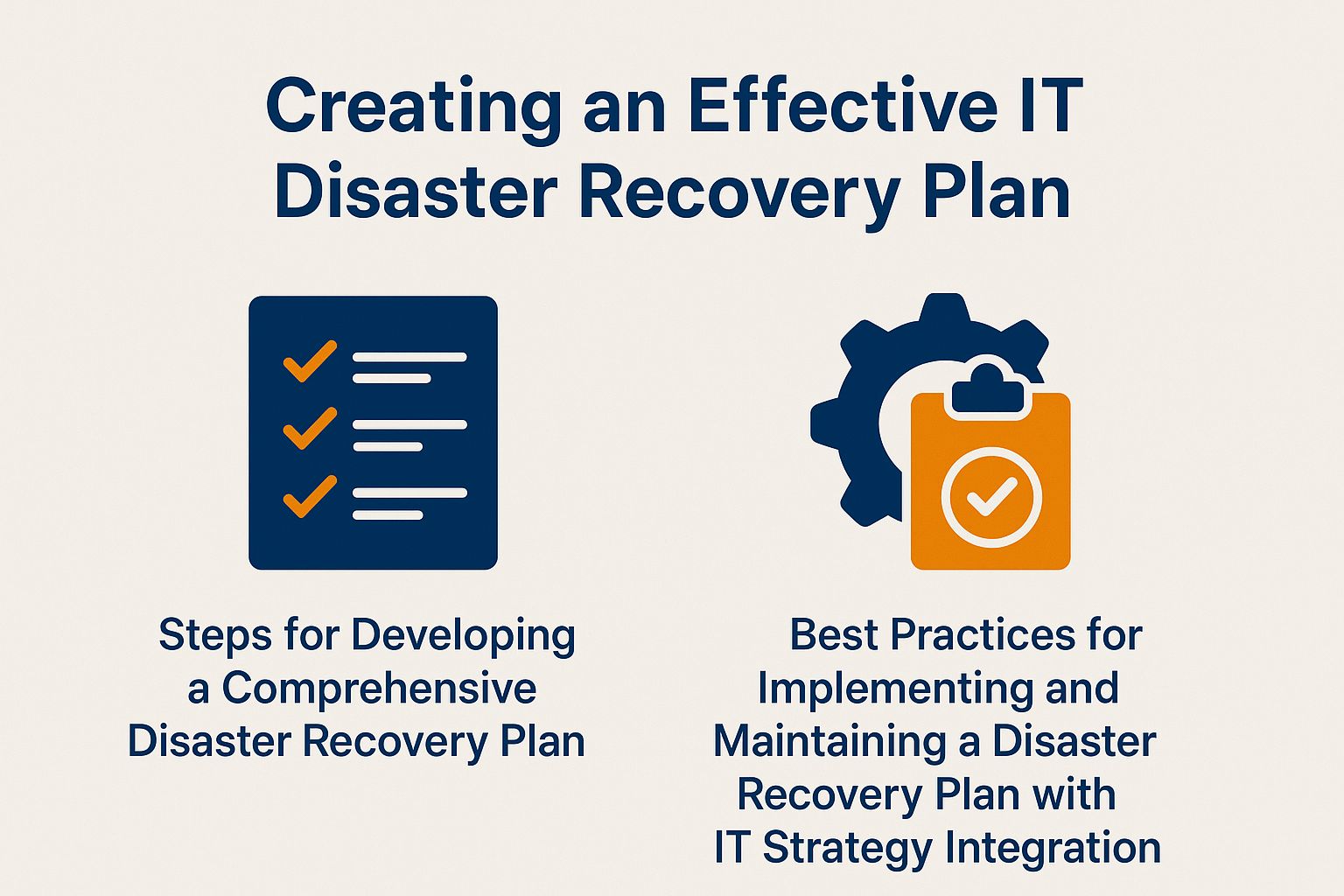IT Disaster Recovery Planning with Local Support

Today, IT disaster recovery planning is crucial. This process includes developing strategies that mitigate risks and enhance resilience. Cloud recovery solutions enable businesses to recover quickly. This article defines disaster recovery planning. It covers IT strategy, types of disasters, system failures, data center recovery, and the role of local IT support teams. The discussion will highlight the essential elements of effective IT disaster recovery planning.
Understanding IT Disaster Recovery Planning and Emergency Procedures
IT Disaster Recovery Planning is crucial for organizations. It ensures business continuity during unforeseen events. A comprehensive Disaster Recovery Plan (DRP) focuses on IT governance, risk mitigation, and risk management. It includes data backup, data loss prevention, system redundancy, and incident response protocols. For businesses looking to strengthen their defenses, understanding the comprehensive IT security services available can be crucial to safeguarding their operations.
These plans significantly influence an organization’s ability to maintain resilience, comply with regulations, and protect data integrity.

Definition and Importance of Disaster Recovery Planning
Disaster Recovery Planning helps organizations prepare for and respond to events that disrupt operations and IT infrastructure. This planning is vital for Business Continuity. It ensures critical systems can be restored within defined limits like Recovery Time Objective (RTO) and Recovery Point Objective (RPO).
Through comprehensive IT Risk Assessments and technology assessment, organizations can identify vulnerabilities and develop effective Recovery Strategies that prioritize essential functions while minimizing potential data loss.
Plus these key components, the planning process necessitates the establishment of clear policies and procedures that guide response actions during a disaster. Engaging stakeholders is crucial. This gathers insights and aligns with organizational goals.
Regularly updating and testing the recovery plan helps organizations refine strategies and adapt to new threats. Incorporating data backup solutions and cloud recovery options further ensures that each organization can sustain operations, even in the face of significant disruptions.
By following IT best practices, businesses can protect their assets and improve resilience in an unpredictable environment.
Types of Disasters and Their Impact on IT Systems
Organizations encounter various types of disasters that can significantly affect their IT infrastructure, ranging from natural disasters such as floods and earthquakes to man-made incidents like cyber-attacks and system failures. Understanding these potential threats is essential for developing effective incident response strategies and strengthening defenses against cybersecurity risks.
Each type of disaster presents unique challenges that can reveal system vulnerabilities, potentially leading to data loss and operational disruptions, which underscores the importance of proactive planning to maintain business functionality.
Conducting thorough risk assessments helps organizations find vulnerabilities that may be exploited during disasters. This proactive stance enables businesses to create comprehensive security protocols, establishing an effective framework for data protection and system recovery.
Strong backup solutions and clear communication plans help employees understand their roles in emergencies.
Regular training and simulations prepare teams to respond quickly to threats. This reduces damage and ensures business continuity. Staying updated with the latest IT developments is also crucial. Resources like Columbia Technology News provide valuable insights into recent trends and strategies that can strengthen your disaster preparedness efforts.
Local Support for IT Disaster Recovery
Local Support is vital for effective IT Disaster Recovery. It offers specialized IT Support Services tailored to local businesses, which brings numerous advantages to the community. One of the key benefits is enhanced disaster recovery processes through close collaboration with a reliable local IT support team.
Using Local IT Services gives organizations timely help and expertise, which is crucial during emergencies. This collaboration facilitates quicker incident responses and strengthens community relationships.
Local IT Expertise helps organizations handle challenges better and maintain continuity with a strong support network.

Benefits of Local Support in Disaster Recovery Planning
Integrating Local Support into Disaster Recovery Planning offers many advantages. It enhances an organization’s emergency preparedness and resilience. Access to nearby IT Support Services facilitates the rapid deployment of resources during a crisis, ensuring effective resource allocation and minimizing downtime.
Local support teams understand regional challenges and regulations. This knowledge helps create recovery strategies that fit the organization’s needs.
This localized expertise enables a quicker response to emergencies, reducing the time required to recover critical systems and data. Their familiarity with community-specific risks ensures that recovery plans adequately address potential natural disasters or other local emergencies, enhancing their overall effectiveness.
Additionally, local support teams can navigate government regulations and industry standards with proficiency, ensuring compliance while mitigating potential legal issues.
Local support strengthens business continuity and builds trust. Organizations can rely on available resources when needed.
Key Roles and Responsibilities of Local Support Teams
Local Support teams play a pivotal role in IT Disaster Recovery by managing essential responsibilities that contribute to effective Incident Management, contingency planning, and operational continuity. Their duties typically encompass maintaining technical documentation, coordinating recovery efforts, and ensuring ongoing communication with clients during and after a disaster, supported by an effective communication plan.
By having dedicated Local Support, including remote support, organizations can enhance their recovery capabilities and ensure that all stakeholders are informed and prepared to implement the recovery plan efficiently.
These teams serve as the first line of defense when incidents arise, providing technical expertise, promptly addressing issues to minimize downtime. They are tasked with documenting procedures and configurations to ensure that critical knowledge is preserved and accessible during challenging circumstances.
The significance of timely and transparent communication is paramount; Local Support teams ensure that clients remain informed about the status of the recovery process, thereby fostering trust and stability. Their proactive approach establishes a solid foundation for a seamless transition back to normal operations, making them a critical asset in an organization’s resilience strategy and IT troubleshooting efforts.
How to Create an Effective IT Disaster Recovery Plan
Creating an effective IT Disaster Recovery Plan requires a comprehensive approach that involves a thorough understanding of an organization’s IT operations, IT architecture, and business needs.
A well-structured plan outlines essential Recovery Procedures that enable the organization to respond promptly and efficiently to disruptions.
Incorporating Configuration Management and regular testing helps organizations create a strong Business Recovery Plan. This plan meets compliance regulations and boosts operational resilience in the face of potential disasters. For organizations seeking to enhance their disaster recovery capabilities, having robust IT support services ensures that all technical needs are efficiently managed.

Steps for Developing a Comprehensive Disaster Recovery Plan
Developing a Comprehensive Disaster Recovery Plan involves several crucial steps. First, conduct a business impact analysis. This ensures all aspects of the organization’s IT infrastructure are considered.
The process starts with an IT Risk Assessment and an infrastructure assessment. These help identify vulnerabilities and potential impacts. Next, formulate a Recovery Strategy that outlines specific recovery objectives.
Communicate effectively with stakeholders during this process. This gathers insights and aligns with organizational goals.
Regular IT audits and post-incident reviews are necessary. They help maintain the plan’s relevance and effectiveness over time.
This systematic approach builds resilience. It also enhances decision-making when unexpected disruptions occur. Identifying critical assets, determining acceptable downtime, and evaluating third-party dependencies are integral components of the risk assessment stage.
Once a clear Recovery Strategy is established, organizations must implement robust testing scenarios to ensure that all team members understand their roles during an incident and that the strategies are practical under real-world conditions.
Reinforcing accountability through ongoing training and simulations helps to instill a culture of disaster preparedness. Continuous feedback from involved stakeholders is vital to ensure that evolving risks and technologies, along with IT policies and IT resilience strategies, are integrated, keeping the plan agile and effective.
Best Practices for Implementing and Maintaining a Disaster Recovery Plan with IT Strategy Integration
To implement and maintain an effective Disaster Recovery Plan, follow best practices. This ensures its functionality and relevance over time. Organizations should prioritize robust backup systems to protect critical data. This includes cloud backup solutions. They should also conduct regular Disaster Recovery Testing to validate recovery procedures and ensure IT compliance.
A focus on System Restoration processes, alongside adherence to IT Best Practices and performance metrics, will enable ongoing improvements and adjustments as organizational needs and technologies evolve, including IT asset management.
By adopting a systematic approach to analyzing potential risks and impacts through IT risk management, businesses can enhance their resilience against unforeseen disruptions. Document each stage of the disaster recovery process. This facilitates clearer communication among stakeholders and streamlines onboarding for new team members.
Organizations must cultivate a culture of continuous improvement. Regularly revisit and update strategies based on feedback from past incidents and evolving industry standards, as mentioned in our analysis of Proactive IT Monitoring for Growth in Columbia. Regular staff training on these procedures builds confidence and prepares teams to respond effectively during a disaster.
Frequently Asked Questions
What is IT Disaster Recovery Planning and IT Governance?
IT Disaster Recovery Planning is the process of creating a plan and procedures to recover and restore critical IT systems and operations in the event of a disaster or major disruption, incorporating technology recovery strategies. This includes identifying potential risks, assessing their impact, and developing strategies, such as failover solutions, to mitigate and recover from them.
Why is IT Disaster Recovery Planning important for businesses and their IT environment?
IT Disaster Recovery Planning is crucial for businesses to ensure the continuity of their operations and minimize the impact of a disaster through effective downtime minimization strategies. It helps to maintain customer satisfaction and protect the company’s reputation and financial stability, supported by IT troubleshooting and incident response plan methodologies.
What is local IT support in IT Disaster Recovery Planning?
Local IT support in Disaster Recovery Planning means having a team or individuals responsible for managing and executing the recovery process during a disaster.
How does local IT support aid in IT Disaster Recovery Planning and business operations?
Local IT support helps businesses recover faster. They know the systems well. Communication with other teams is easier.
What should be included in an IT Disaster Recovery Plan and IT architecture?
An IT Disaster Recovery Plan should include: a risk analysis, recovery procedures, a communication plan, team roles, and a testing schedule. This ensures the plan is up-to-date and effective.
How often should an IT Disaster Recovery Plan be reviewed and tested with system health checks?
Review and test the IT Disaster Recovery Plan at least once a year. Include system health checks to confirm it works well and to make updates. Review it when there are major changes in IT systems or operations. This may include hardware updates and changes to backup frequency.




